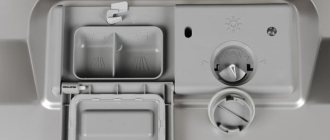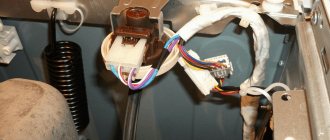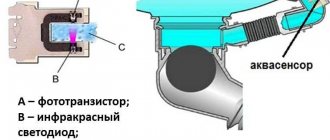Operating a dishwasher involves constant interaction with the door; the machine often needs to be kept open for a long time: to load or unload dishes, clean filters, and add detergents. If the door constantly tries to close, you will have to constantly support it, which is extremely inconvenient.
PMM manufacturers know this, which is why they equip the units with mechanisms that fix the door. However, complaints about the slamming or, conversely, falling door still do not stop coming. Today we will tell you what to do if you have problems opening the dishwasher.
What does the locking mechanism consist of?
First, let's look at the internal structure of the PMM to make it easier to determine the breakdown.
The locking mechanism is located inside the door and consists of the following elements:
- metal spring;
- cable (metal or fabric);
- plastic locking element;
- loops.
Some models, such as Bosch, also have closers that make the door move smoother.
The mechanism of operation of this system is simple. You open the dishwasher and thereby set the hinges in motion. This increases the tension of the cable, and it, after itself, stretches the spring. When the spring is stretched to its maximum, the locking element falls into a special hole and fixes the structure, preventing the spring from closing. At this moment, the PMM can safely be in the open position. As soon as you want to close it and move the door up, the lock will come out of the grooves and allow the spring to slam the door.
That is why PMMs that are not equipped with closers should be held when closing. If this is not done, the door will slam loudly and there will be a jerk that can damage the internal mechanisms or the housing.
Progress
Having gone through all the steps of the preparatory stage, you can begin repair work. You won’t be able to adjust or remove the door right away—you need to start slowly but surely disassembling the PMM. First you need to remove the side walls and the top cover; behind them lies a smooth opening mechanism. No further disassembly is required. Just in case, take notes on the disassembly steps to avoid mistakes:
- Unscrew the fasteners that hold the right side wall. Remove and set aside the panel.
- Repeat the operation for the second wall.
- Unscrew the screws that hold the top cover in place, remove it, and set it aside.
Under the cover you will see two fasteners from which cables extend in different directions. They run along both sides of the body, connecting at the end with the springs. This is what the soft opening mechanism looks like, which needs to be adjusted.
Armed with a hexagon, tighten the screws from which the cables that tension the springs come. If the door opens with difficulty, you need to loosen the tension of the springs, and if the door does not hold, you should increase the tension.
It is much worse if one of the cables bursts from the load. In this case, the second one works for two people, and therefore does not perform the functions assigned to him. Regulation is pointless - you need to replace the damaged element. Proceed as follows:
- loosen the screw that holds the broken cable;
- Use pliers to remove it from the screw;
- disconnect from the spring;
- buy a new original or similar item;
- unpack;
- put the cable on the spring;
- Grab one end with pliers, pull it tight and hang it on the screw;
- adjust the tension;
- assemble the machine.
After installing a new blocker, do not rush to assemble the equipment. Holding the cable and spring, check how well the hopper closes and opens, and whether the flap is held in the open position. Only after making sure that everything is functioning correctly can you put the case back together.
Dishwasher door closing
Every dishwasher must be locked in the open position. Some models have 2 opening positions: open and half-open. Moreover, a number of PMMs can even be fixed in any position you choose.
Such opportunities are due not only to ease of use. The dishwasher tank usually has high humidity and a sufficient amount of heat - and these are ideal conditions for the development of bacteria and mold. To ensure the tank is well ventilated, it is recommended to keep the dishwasher open as often as possible. But it is impossible to do this with a broken fixation system.
If the dishwasher door does not lock in the open position, the opening mechanisms are most likely out of adjustment or broken. You can solve these problems at home without special training.
Adjusting the closing system yourself
As a rule, new PMMs suffer from adjustment problems. The thing is that when they leave the factory, built-in dishwashers are not adjusted and the dishwasher door is not fixed. It is assumed that the technician will select the required degree of fixation when installing the device and hanging the facade.
If this does not happen, or the technician made a mistake, you can correct the situation yourself. To do this, you need to open the door all the way and unscrew the screws securing the inner surface of the door. Once the structure is disassembled, you will see a locking mechanism. You need to find the screws at the base of the hinges that hold the cables and loosen them. To do this, take a hexagon and tighten the screws a little. After the procedure, reattach the cover and check the movement. The problem must be resolved.
Replacing a broken element
If the adjustment does not help and you notice damage to the locking mechanism, you need to replace it.
It also opens access to the “filling” and temporarily weakens the spring tension to a minimum. We remove the cable cover, dismantle the old locking system and install a new one in its place.
If during inspection you notice that only one element has failed (for example, the blocker is bent), you can replace it individually, leaving the old system intact. But, as practice shows, replacing the entire system is much easier than selecting a new element.
Repairing and adjusting the door in dishwashers, how to adjust or install a door in a dishwasher
There is always a mountain of dirty dishes in the dishwasher. For a large number of housewives, it is convenient to wash dishes only when a lot of them have accumulated, because in this way less detergent is consumed. Every time you need to put dirty dishes in the washing hopper, you have to open and close the machine doors.
Let's think about how the return spring on the door acts when it constantly strives to close. Therefore, you need to hold the door and put the dishes into the container with your free hand.
This is quite dangerous, because if you don’t hold it, you can break all the dishes or injure a limb.
Why does the door keep closing? Could this be a design violation or a malfunction? What to do, how to fix the breakdown? There is always a specific answer to every question.
Possible malfunctions of the dishwasher
When the service life of your equipment exceeds five years, you should think about simple wear and tear of parts. However, in the case when the equipment was purchased recently, then various malfunctions of the dishwasher can be caused by the following factors:
- Cheap models often feature low-quality parts;
- Severely clogged plates can cause filters to become clogged, after which water will not flow through. Before loading, you should thoroughly clean the dishes from food residues;
- Poor cleaning of dishes is possible due to the use of low-quality detergents;
- If the door is not closed tightly, you will notice how the dishwasher leaks. It also happens that the door closes poorly, and this indicates that it was installed incorrectly by the manufacturer;
- It makes sense to load dishes correctly: the upper compartment is intended for cups and plates, and large dishes are placed below.
In a situation where the above reasons do not apply, you should think about bad parts that have the potential to fail.
Door fixation
Dishwashing machines are designed in such a way that the door is always locked in any position. However, our issue is that there is no commit. Thus, to fill the washing machine with dirty dishes, you will need to hold the door with your knee so as not to break the dishes and carefully place them.
Often in such a case, the locking system of the door itself fails. However, it also happens that incorrect adjustment can lead to improper operation of the mechanism. This is due to the fact that built-in dishwashers are not supplied from the factory with the door already adjusted. This is necessary so that the master can install it without hindrance.
The mechanism that is responsible for fixation
To understand how to secure the dishwasher door, you need to look inside where it is attached. There you can see:
- Special spring;
- Cable;
- Fixing element for locking, which consists of plastic;
- Loop.
The loop begins to move when we fully open the machine door. To open it, you need to apply a certain force, which is quite enough for the spring to stretch as much as possible.
The locking element secures the cable, so that the spring does not pull back, thereby keeping the doors open. They will remain in this position until you close them yourself. The blockage will immediately be released, which will lead to compression of the spring, which will tighten the cable.
The PMM door falls
It is also not uncommon for situations when, having opened the dishwasher, you have to hold the door so that it smoothly lowers all the way and does not fall. This situation indicates that the closing system is not coping.
This may be due to the façade being too heavy. If you know its weight, look at the operating instructions for the PMM and check whether it is suitable for you. If not, it is better to replace the facade or remove it altogether. If everything is in order, it is worth adjusting the cable tension screws. Only now you need not to weaken, but to tighten the system.
If this does not help or it is no longer possible to tighten the cables, replace the locking system. Most likely, your cable has burst or the spring has broken, so if possible, purchase a more powerful spring and closer.
Other possible problems with dishwasher doors
Other problems may arise with PMM doors.
The door does not lock
If the door does not lock in the closed position, that is, the PMM does not perceive it as closed and does not block it, the washing cycle cannot be started - the lock is activated. As a rule, such a situation is indicated by an error on the control panel. It is quite difficult to cope with such a problem alone, since it concerns electronics. Most likely, the technician will advise you to replace the electronic lock.
You can purchase all the necessary spare parts in the Spare Parts for All store. We are ready to help you with your choice and select the element that suits your specific model.
Door leaks water
If water flows from under the door, but the pressure is strong enough, most likely the problem is the seal. Replace the old sealing rubber and the damage should be eliminated.
The door creaks
If you hear strong creaking sounds when opening, you should take this problem seriously - ignoring squeaks can lead to abrasion and serious damage to the system.
Inspect all hinges and lubricate them with a special compound. If the sounds do not stop, call a technician. The hinges may be damaged and need to be replaced.
Finally, I would like to remind you about the rules for using PMM, which will help you avoid problems with doors. Do not place heavy objects on the open door or slam the camera suddenly. Handle your dishwasher with care, then it will serve you faithfully for many years.
Lock installation and repair
It is quite possible to replace the dishwasher door lock yourself; before you begin, buy an original spare part for your machine model. Let's consider the replacement algorithm using the example of a Bosch dishwasher:
- The installation begins by opening the machine door and unscrewing the bolts around the perimeter that hold the front panel.
Be careful to hold the door panel with your hands so that it does not fall and pull the wires along with it.
- Take a photo of the location of the wires on the lock and disconnect them.
- Next, on the top of the door you need to unscrew the two cross bolts that hold the lock.
- Take the new lock and screw it in place of the old one.
- Connect the wires and assemble the door. The installation of the new lock is complete.
In some cases, you don’t have to buy a new lock, but rather repair the old one. Usually, the retaining “tendrils” of the plastic lock on dishwashers break off. This is how they can be restored. To do this you will need:
- metal plate 0.5 mm thick and 4 mm wide;
- file;
- drill;
- two small screws;
- a little patience.
Using a file, it is necessary to sharpen the uneven edges of the broken tendrils. And bend a bracket from tin as shown in the photo.
Next, you need to use a drill to make holes with a diameter of 1.5 mm on the sides of the metal plate. On the sides of the lock you need to make holes with a diameter of 1 mm, so that their location coincides with the holes of the plate. We connect the plate and the lock with small self-tapping screws. Now you can install the lock on the door.
Changing the rubber seal
Installing the rubber seal located along the contour of the dishwasher under the door is even easier. Let's look at replacing the rubber band using the Zanussi dishwasher as an example.
- First you need to tear off the old rubber band with your hands.
- Next, take a rubber band for your dishwasher, which can be purchased at a specialized spare parts store.
- Now you need to insert a new rubber band in place of the old one so that it fits tightly into the groove, gradually moving along the perimeter of the body.
- If the elastic is too long, you need to cut off the excess with scissors.
What to do if the door does not lock
Very often, after purchasing a new built-in dishwasher, users complain that the door is very difficult to open and does not lock in the open position. However, this is not a reason to panic. In fact, the door will open well only after it is installed and secured to the facade door.
In addition, the machines have spring tension adjustment. In some dishwasher models, for example Samsung, the adjusting bolts are located on the top. There are dishwashers, such as Bosch, that have adjustment bolts on either side of the door at the bottom of the dishwasher.
For your information! The tighter the bolts are tightened, the greater the force required to open the door. Typically, this force ranges from 2.5 to 8.5 kg.
So, the dishwasher door may not close for a number of reasons, one of which is improper installation of the built-in dishwasher. In most cases, this problem can be fixed by yourself. Be patient and follow the instructions.
Interesting:
- Detergents for children's dishes
- How to use a dishwasher correctly
- Dishwasher rating 45 cm
- Containers for washing powder
- Dishwasher leaking
- Miele dishwasher repair
1 reader comment
- 03/10/2018 at 23:58
Specy:
Thanks a lot! Helped save the dishwasher
Answer











